|
|
Obi Sash Belts for Kimono
Obi sash belt types for japanese kimono, kimono sash and how to tie an obi belt, types of japanese obi and how to wear a kimono and an obi belt.
 Continued
from How to Wear a Kimono ....
Continued
from How to Wear a Kimono ....
How
to Tie an Obi Sash and Belt
Contrary to belief, the traditional obi belt is actually
comprised of many belts. Below are instructions on how to tie each belt
over the kimono.
- After you have put on your kimono per the steps shown on the page How
to Wear a Kimono.
- Pull up the kimono material so the length of the kimono is at the ankle. The
length of the kimono is always adjusted which is why there are only
a few lengths made by the manufacturer.
- As you hold the extra material above your waist, tie the koshi-himo
belt below the excess material. Cross the belt in the back
and tie it in the front.
- Straighten out the excess material to the side so that the front
and the back of the kimono are smooth.
- Bring down the excess material to cover the belt.
- Take the date-jime belt and wrap it around your waist
covering the koshi-himo belt. Tie the date-jime belt in the front
leaving the overlapping kimono fabric visible below. The excess
kimono fabric should hang evenly below the belt so that the fabric
is seen as shown in the picture above.
The traditional long obi can be very difficult to
tie depending on the style of bow made. Many times, another person
will tie the belt for you. There are many styles of different ties
that can be made with the belt. Below is information on pre-tied obi
belts and how to tie your own butterfly bow. The obi-jime is the last belt tied around the obi belt as shown
in the picture above.
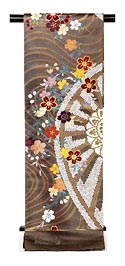 Formal
Obi Belts
Formal
Obi Belts
A woman's formal obi is usually 4 meters long and 60 centimeters
in width. The width is folded in half and the obi is wrapped twice
around the waist and then tied in the back. Formal obi belts are made of a
brocade or tapestry weave. The more pattern, the more formal is the
basic rule. Today, an obi completely covered in its entirety with woven
or embroidered design are now normally worn by a bride.
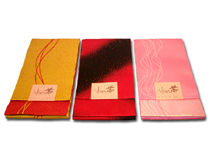 Casual
Obi Sash
Casual
Obi Sash
Obi for casual wear may be as narrow as 10 centimeters or as
wide as 30 centimeters. They are are usually made of satin, twill, chirimen, gauze weaves, cotton,
nylon or wool. The main difference between the formal obi and the casual
obi is the material. Casual obi are not made of silk and do not have the
elaborate silk brocade embroidered patterns. Although called casual,
many are not casual looking at all. It is worn both with the kimono and
the summer kimono "yukata".
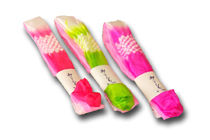 1)
Koshi-Himo Sash
1)
Koshi-Himo Sash
The koshi-himo belt is the first belt tied around the waist.
The belt is available in a variety of styles, materials and some newer
styles even have velcro. The koshi-himo belt shown here is made of tye-dyed
silk.
 2)
Date-Jime Belt
2)
Date-Jime Belt
The date-jime belt is the second belt tied around the kimono
covering the first koshi-himo belt.
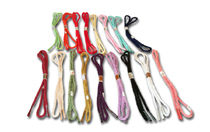 2)
Obi - Jime
2)
Obi - Jime
The obi-jimi is a braided cord tied on top of the obi.
Because the obi-jime is visible, it comes in a variety of colors and the
color is chosen to compliment the obi.
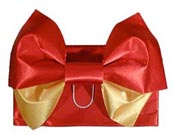 Butterfly
Obi Belts
Butterfly
Obi Belts
This obi is a pre-tied belt that gives the impression of the
complicated tied obi but is very simple to put on. The tied bow shape is called cho
cho for the bow resembles the butterfly, thus giving it the name
butterfly obi. The belt consists of two
pieces; the wide belt and the bow. The belt is 5 feet in length and 6
inches in width The belt is wrapped twice around the waist and tucked
under. The bow has a wire hanger to insert into the wrapped around
belt. You can find butterfly obi belts at JapaneseGifts.com.
Tie
your Own Butterfly
Obi
Below are instructions on how
to tie a single tie butterfly obi by yourself with a long traditional
belt. The finished bow will look as the yellow portion of the picture
shown above (basically a single tied bow). To tie the bow yourself, the
bow will be tied in the front and the obi belt will be twisted after it
is done so the bow is in the back.
- Place the long obi fabric around the waist with the ends toward
the front. Position the obi fabric so that about 50 cm of the belt
is in your left hand and wrap it once more around the waist.
- Overlap the ends of the obi toward the front so that it crosses
over and tie the belt once with the right end over the left.
- You will now have one shorter end towards the top and one long end
hanging down. Twist the tie so that the short end goes over your
right shoulder.
- Fold the long bottom end in half or twice to get the size bow you
want. This end is the actual right and left side of the bow.
- To make the center tie that holds the bow together, take the end
that is over your shoulder and wrap it around the center of your
folded piece several times. Any excess portion of the belt should be
hidden underneath.
- Turn the belt around toward your back.
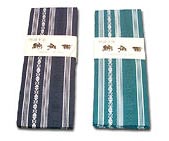 Mens
Obi Belts
Mens
Obi Belts
There are two main types of men's obi belts used with men's kimono and
summer kimono (yukata). They are either called kaku or heko.
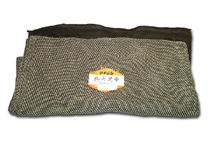
The stiff
belt as shown above and are called kaku obi. The kaku
obi is about 3.5 inches in width and made of cotton. The soft obi sash is called a heko obi and is normally free flowing and made of tye-dyed fabrics.
 Continued
from How to Wear a Kimono ....
Continued
from How to Wear a Kimono .... Formal
Obi Belts
Formal
Obi Belts Casual
Obi Sash
Casual
Obi Sash 1)
Koshi-Himo Sash
1)
Koshi-Himo Sash 2)
Date-Jime Belt
2)
Date-Jime Belt 2)
Obi - Jime
2)
Obi - Jime Butterfly
Obi Belts
Butterfly
Obi Belts Mens
Obi Belts
Mens
Obi Belts